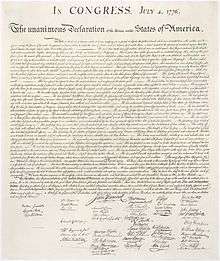George Ross (delegate)
| George Ross | |
|---|---|
 George Ross. 1873 oil painting by Philip Fishbourne Wharton after Benjamin West. | |
| Born |
May 10, 1730 New Castle, Delaware |
| Died |
July 14, 1779 (aged 49) Philadelphia, Pennsylvania |
| Resting place | Christ Church Burial Ground, Philadelphia |
| Known for | signer of the United States Declaration of Independence |
| Signature | |
|
| |
George Ross Jr (May 10, 1730 – July 14, 1779) was a signer of the United States Declaration of Independence as a representative of Pennsylvania. He was also the uncle of the man who married Betsy Griscom in 1773, giving her her famous married name: Betsy Ross. In 1952, he, George Washington, and Robert Morris appeared on a 3-cent stamp commemorating Betsy Ross.
Life
He was born in New Castle, Delaware, and educated at home. He studied law at his brother John's law office, the common practice in those days, and was admitted to the bar in Philadelphia. Initially a Tory, he served as Crown Prosecutor for 12 years and was elected to the provincial legislature in 1768. There, his sympathies began to change, and he became a strong supporter of the colonial assemblies in their disputes with Parliament.
He was a member of the Committee of Safety, and was elected to the Continental Congress. He was a colonel in the Pennsylvania militia (1775–1776), and vice-president of the first constitutional convention for Pennsylvania. He resigned from the Continental Congress in 1777 because of poor health, and was appointed to the Pennsylvania Court of Admiralty where he died at age 49.
George Ross was born May 10, 1730 at New Castle Delaware. His dad was Rev. George Aeneas, the 5th Laird Balblair Ross (b.1679, d.1754), who had 2 wives and 16 children, and was an Anglican clergyman who had immigrated from Scotland. Their paternal line goes back to Farquhar Ó Beólláin (1173-1251) who King Alexander II 1st Earl of Ross in 1226 after great wins in battle.
The Ross children received a sound classical education at home. He studied law at his half-brother John's Law Practice in Philadelphia. George's sister Gertrude married Thomas Till, the son of William Till, a prominent Sussex County judge and politician; after his death, she married George Read, another signer of the Declaration.[1]
Betsy Ross (born Elizabeth Phoebe Griscom in 1752) only had her famous last name "Ross" for 4-years, which she obtained by marrying John Ross (b.1752, d.1776) in 1773. John was a nephew of George Ross. John was the son of Rev. Aeneas Ross (b.1716, d.1782) and Sarah Leach. George and Aeneas were brothers. John and Betsy had a sewing business, but John died 1/10/1776 in Philadelphia by explosion while guarding a munitions building during the Revolutionary War. Betsy would often tell her children, grandchildren, relatives, and friends of the fateful day when three members of a secret committee from the Continental Congress came to call upon her. Those representatives, George Washington, Robert Morris, and George Ross, asked her to sew the first flag. This meeting occurred in her home some time late in May 1776. The Stars and Stripes design Ross may have designed was officially adopted by the congress on June 14, 1777. The next day, June 15, 1777, Betsy married Joseph Ashburn, thus becoming Betsy Ashburn.
George Ross was the last of the Pennsylvania delegation to affix his signature to the Declaration of Independence. He had been loyal to the King but he soon became disgusted with Tory politics and supported the cause of the Patriots.
In 1750, he was admitted to the Pennsylvania Bar (member of Pennsylvania) when he was 20 years old, and he established his own practice in Lancaster. In 1751, he married Ann Lawler at Lancaster, Pa. He fathered two sons and a daughter. From 1768 to 1776, he was for 12 years Crown Prosecutor (which is attorney general) for Carlisle (Cumberland County), until 1778 when he was elected to the provincial legislature of his state.
He was elected to Continental Congress in 1774, 1776, 1777. He was a Colonel in the Continental Army in 1776. In 1776, he undertook negotiations with the northwestern Indians on behalf of his Colony and that year he acted as vice president of the State constitutional convention, so then that led to helping draft a declaration of rights. He was re-elected to the Continental Congress again in January 1777 but resigned that same year because of poor health. He was vice president of the Pennsylvania constitutional convention and was the Judge of the Admiralty Court of Pennsylvania in 1779. In 1778, while he was acting as admiralty judge, a congressional court of appeals overruled his decision in a case involving a dispute between a citizen of Connecticut and the state of Pennsylvania. He refused to acknowledge the authority of the higher court to counter State decisions, which initiated a dispute between manifestation of the states' rights controversy and did not subside until 1809.
In 1779 he died in office at the age of 49, and is buried at Christ Church Burial Ground in Philadelphia.[2]
References
- ↑ Biography of Gertrude Ross Read Colonial Hall
- ↑ George Ross at Find a Grave
https://www.mysticstamp.com/Products/United-States/1004/USA/# http://www.ushistory.org/betsy/more/weisgerber.htm
